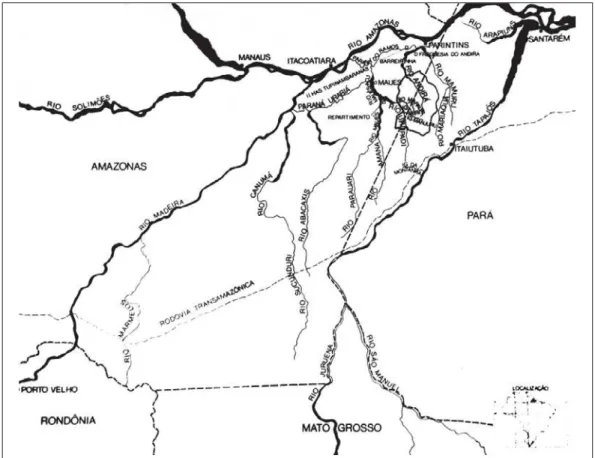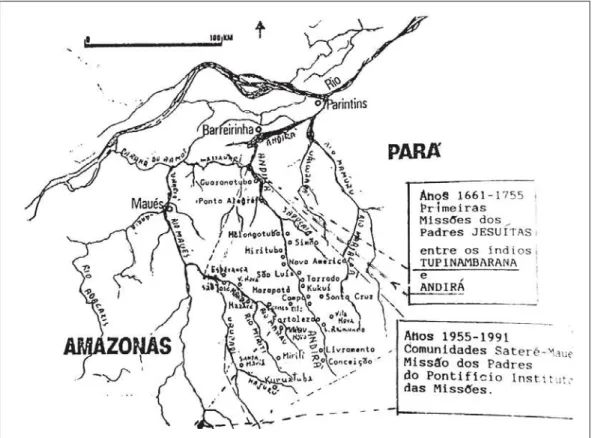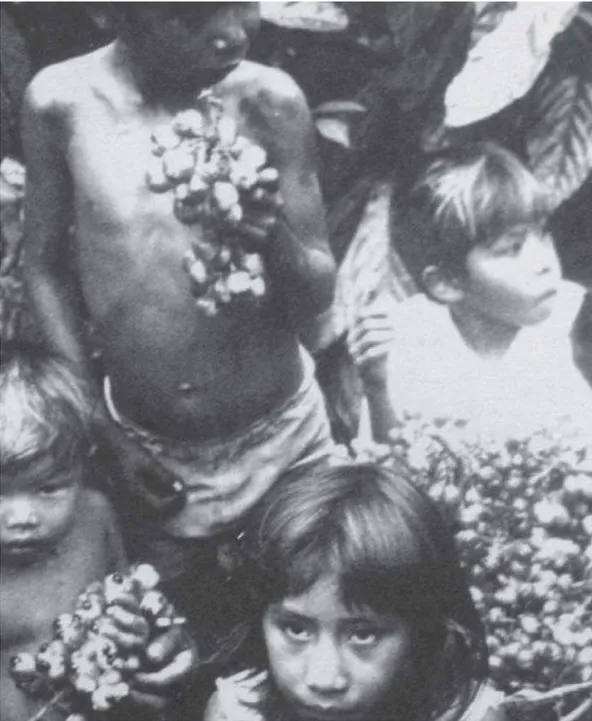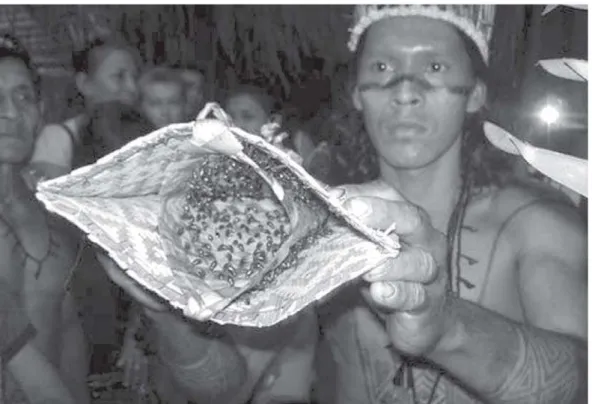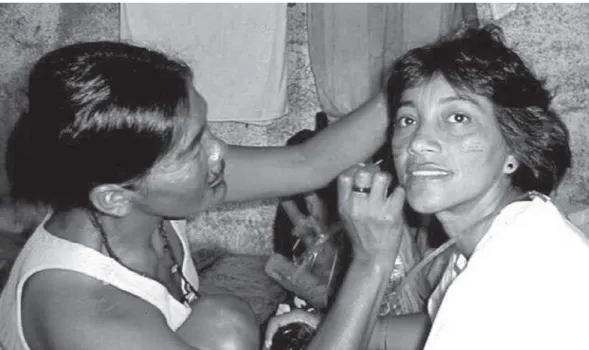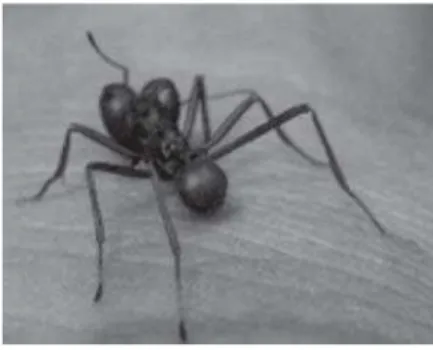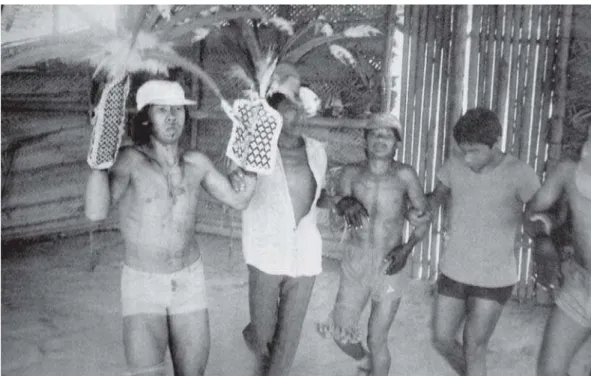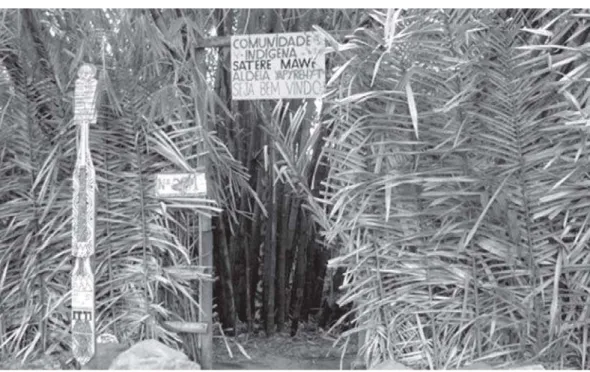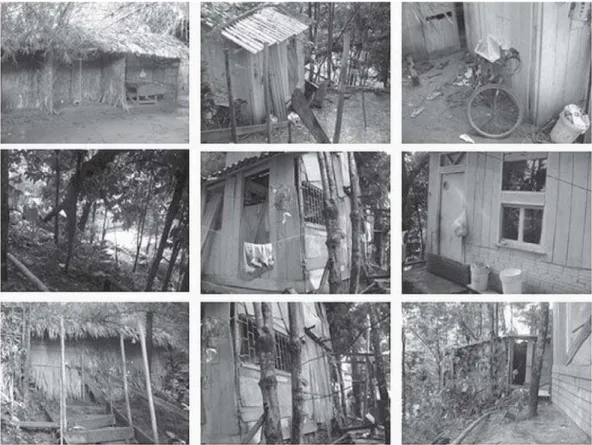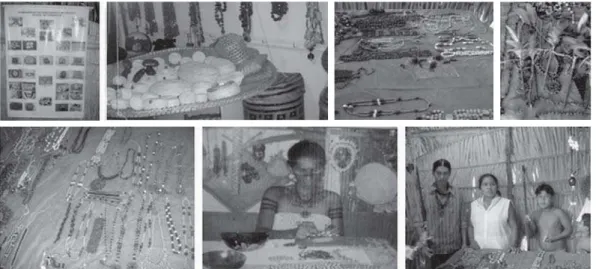The Sateré-Mawé
community of
Y’Apyrehyt: ritual and
health on the urban
outskirts of Manaus
João Bosco Botelho
Doctor Honoris Causa of the Paul Sabatier Toulouse III University; Professor of History of Medicine at Universidade Estadual do Amazonas and Universidade Nilton Lins; Professor of the
Programa de Pós-graduação em Biotecnologia at Universidade Federal do Amazonas.
Av. Eduardo Ribeiro, 520/705 69010-010 – Manaus – AM – Brazil
joaoboscobotelho@gmail.com
Valéria Augusta C.M. Weigel Professor of the Programa de Pós-graduação em Educação
at Universidade Federal do Amazonas. Rua Rio Jutaí, 63, Quadra 3 – Conj. Jardim Olívia
69053-020 – Manaus – AM – Brazil valeriaweigel@hotmail.com Received for publication August 2009. Approved for publication January 2011.
BOTELHO, João Bosco; WEIGEL, Valéira Augusta C.M. The Sateré-Mawé community of Y’Apyrehyt: ritual and health on the urban outskirts of Manaus. História, Ciências, Saúde – Manguinhos, Rio de Janeiro, v.18, n.3, jul.-set. 2011. Available at: http:// scielo.br.
Abstract
The Y’Apyrehyt community, one of three belonging to the Sateré-Mawé indigenous people found on the outskirts of Manaus, is located in a former nature reserve, the Parque das Seringueiras. The community comprises 67 people, adults and children, who live from the income obtained from tourists paying to see the Tucandeira Ant Ritual and from the sale of craftwork. Even with the Magic Oar – the puratin or poratig – displayed at the entrance to the community, only the Tucandeira Ant Ritual remains alive today. The process of attributing new meanings to this ritual has involved both an aesthetic dimension, evinced in its artistic choreography, and its commercialization. Keywords: Sateré-Mawé Indigenous People; Tucandeira Ant Ritual; Manaus (Amazonas State, Brazil); twentieth and twenty-first centuries.
T
he first migrations of the Sateré-Mawé to Manaus took place between 1970 and 1980 in a primarily female-led process. On arriving in the region, access to the job market was easier for women, who could find employment as domestic workers. Despite some doubts concerning the reliability of the 2000 census – which also quantified migrant Indians –, 146 of the 333 Sateré-Mawé individuals were from the same family or close kin (Bernal 2009). The urban outskirts of Manaus are home to Sateré-Mawé communities: Y’Apryrehyt, Maué, I’nhã-bé and Waikiru.This article examines some aspects relating to the territorialization and culture of the Sateré-Mawé, apprehended in three periods of fieldwork – the first in 2008 and the other two the following year - in the Y’Apyrehyt community (Silva et al. 2008; Colombo et al. 2009; Queiroz et al. 2009).
If we understand culture to be a system of meanings ordered by a particular logic that governs the way of life of a human group (Geertz 1989), we can identify a rich cultural diversity on the urban periphery of Manaus. The population of the region mostly comprises migrants from Amazonia and other regions of Brazil, and a much smaller contingent of indigenous people, Afro-Brazilians and foreigners, composing a mosaic of cultural multiplicity with which the small Sateré-Mawé communities interact. In these intercultural processes of symbolic exchange, the Sateré-Mawé appropriate various elements from the surrounding cultures and use them to give new meanings to components of their own culture, such as the search for good health or the development of ethnic affirmation strategies.
The records describing the Sateré-Mawé since the colonial period show that the most significant markers of ethnic identity are the ritual consumption ofguarana (Paullinia sorbilis), obtained from cultivated land as a source of health; the cult of the puratin or poratig, the Magic Oar; and the Tucandeira Ant Ritual, a male initiation rite (Bernal, 2009).
For individuals from the Sateré-Mawé community of Y’Apyrehyt – living on a tiny area of land, unsuited for agriculture, on the urban outskirts of Manaus with no chance of carrying on their tradition of planting guarana and lacking a shaman – only the Tucandeira Ant Ritual remains of the their main symbols of ethnic identity. At the same time, this initiation rite has acquired new meanings produced by the intercultural confrontation. The ritual and the therapeutic implications of the ant sting, the focus of our fieldwork observations, combined with the accounts of Moisés, the tuxaua (community leader)- in the Y’Apyrehyt community and in university classrooms – led to the ideas presented in this article.
Some background information on the Sateré-Mawé people
a demarcated land covering 778,528km², created in 1982 (Figure 1), between the municipalities of Maués and Barreirinha, in Amazonas, and Itaituba, in Pará, by the shores of the Andirá, Marau, Miriti, Urupadi and Majuru rivers (Lorenz, 1992). The census cited by Esteves reflected a large increase in the population compared to the data provided by Uggé (n.d., p.5), who in 1986 estimated the population at 4,500 people.
Evidence suggests that in the seventeenth century the Sateré-Mawé occupied vast areas of the plateau and shores of the Tapajós River (Figure 2). As European colonization advanced, the people migrated towards the headwaters of the Andirá, Araticum, Abacaxis and Urariá rivers (Pereira, 2003). They received a variety of names from the colonizers: Maooz, Mabué, Mangués, Jaquezes, Maguases, Magués, Mauris, Maraguá and Magueses. In the historical records, the group is cited by Pedro Teixeira in 1626, by the Jesuit priests João Maria and Samuel Fritz in 1661 and 1691 respectively, and by the Benedictine priest João de São José between 1762 and 1763. In 1669 the Jesuits set up the Tupinambarana Mission on the borders of their territory (Pereira, 2003).
The colonial and provincial records also describe the Sateré-Mawé as sedentary, indicating that they made use of terra preta, fertile soils ideal for planting, and traded guarana with the Portuguese from the first years of the eighteenth century (Menéndez, 1992). This claim is given credence by the fact that a significant part of the people’s mythology emphasizes
close links with fertile soil, Noçoquém, where Onhiamuaçabé, the mythic hero, planted Brazil nut trees and the guarana plant whose fruit serves as a remedy for all ills. Other prominent distinctive features are paricá, a powder obtained from plants and used in curing rituals, and the rituals using the tucandeira ant, the sting of which is employed in a rite of passage marking male initiation.
The Sateré-Mawé managed to survive the colonial relatively well, even conserving their language, in contrast to other more nomadic and warlike peoples in the surrounding regions – including the Mundurucu, the Pirahan or Mura and the Cauahib or Parintintin (Gondim 1938), who were pushed to the edge of extinction.
It is interesting to note that neither Serafim Leite (1950), Nunes Pereira (2003) or the sources from the sixteenth to nineteenth centuries (Menendez, 2002) who cited the peoples on the shores of the Madeira and Tapajós rivers - including the report of the province’s president, João Wilkens de Matos, in 1855 (Amazonas, 1855) - make any mention of the Sateré-Mawé. By contrast, Henrique Uggé (n.d.) identified this people, the Sateré-Mawé, composed by two groups each with their own identity, as descendents of the inhabitants of lands close to the Andirá and Maraguá rivers.
The disagreement over the name of the people received special attention from Esteves (2007), who carried out research in the Sateré-Mawé village of Terra Nova, on the right shore of the Marau River, located in the municipality of Maués:
Firstly I believe it makes sense to ask a few questions about the denomination Sateré-Mawé or Maweria, an ancient term that has a rich meaning for the group. Though little used by contemporary members of the group, the term is polysemic and depicts not only the group’s name but especially what they were in the past, during the course of their social formation. The term Maweria represents the plural form of the name Sateré-Mawé. However the most curious aspect of this word is that it represents an ancient term used by the people from a time when they did not call themselves Sateré-Mawé, but simply Mawé (p.14).
The individuals of this people recognize the denomination Sateré-Mawé – not Mawé – as Moi, a teacher from Weneru School in Terra Nova village, testified to Esteves (2007, p.17): “This term (referring to the word Mawé) is in a way unknown to use, I don’t have the least idea what this name signifies. I don’t think the name Mawé mean speaking parrot, I think this name may have been given to us (by white colonizers) and many of us don’t know that.”1 Likewise the tuxaua Donato from the Simão community on the Andirá River also notes the absence of any identification with the word mawé in isolation: “The name mawé (Mau-é) comes from the fact the whites called us maus [bad/evil in Portuguese], they didn’t like us, so they called us bad” (p.18).
The shift from Mawé to Sateré-Mawé is related to the construction of their own identity within a complex set of historical factors over the course of four centuries. Among these factors we can highlight cultural fusion, including an assimilation of values from groups vying for territories, the struggles to survive the harshness of colonization, and interethnic marriages (Esteves 2007). In this article, following the presented arguments and the testimony of the tuxaua Moises from the Y’Apyrehyt community, the people will be identified as Sateré-Mawé.
The multiple meanings of the rituals
Various vultural aspects differentiated the Sateré-Mawé hugely from their nomadic and more warlike neighbours. In relation to disposal of the dead, they smoked the bodies and buried the remains in funeral urns, while the Mundurucu only decorated the heads (pariuá-a) of friends and enemies alike, keeping them on the end of a spear (pariuá-renãpe) (Pereira, 2003).
The onset of puberty was also treated differently. The Sateré-Mawé held festive ceremonies, culminating in the Tucandeira Ant Ritual with its specific dance. Mention is made in this ritual of clans originating from different ethnic groups, reinforcing the premise that the Sateré-Mawé identity was also forged through interethnic connections (Esteves, 2007). The Mundurucu, on the other hand, favoured the practice of a pubescent girl marrying an older warrior, keeping her in isolation during her menarche.
There is no specific description among the Sateré-Mawé of heroes associated with warfare prowess. This contrasts with the mythic accounts of the bahira, anhanga-pian and tandav-ohú among the Parintintim.
Figure 3: Sateré-Mawé indigenous people and guarana (Uggé, n.d., p.26)
distinguishing them from the other peoples living in nearby territories. The following account cited by Nunes Pereira (2003, p.39), without identification of the author, is representative:
a gourd of water, the fruit provides such strength that when the Indians go hunting from one day to the next they feel no hunger. It also stimulates urination and removes fever, headaches and cramps. Of its usefulness in provoking urination I am well aware; of the rest, I know no more than what I have commonly heard said.
The use of guarana as a source of health, combined with its close association with the cultivated land, can be found in the discourse of the Sateré-Mawé tuxaua Manuel from 1933: “Guarana is good for bringing rain, protecting the swidden, curing diseases and preventing others, winning in war and in love, when two rivals want the same woman” (Pereira, 2003). Even more specifically, we can note the mythic conflict between three siblings, two of them men, Ocumáató and Icuaman, and a woman, Onhiámuáçabe. The mythic origin of guarana provides a dramatically explicit account of the relation with cultivable land as the best way for curing illnesses:
Onhiámuáçabe was owner of Noçoquém, an enchanted place where he had planted a Brazil nut tree, and her brothers did not want her to marry because she knew the remedies for all illnesses. When she became pregnant, her brothers were enraged and in revenge expelled her and took possession of Noçoquém. To enforce the punishment, they ordered the agouti to prevent her from entering. Disobeying these orders, Onhiámuáçabe took her son to eat Brazil nuts in Noçoquém. The boy liked them and returned many times. The furious brothers ordered the child killed. Onhiámuáçabe, discovering her son was missing,ran to Noçoquém and found him there, decapitated. Crying and speaking to her son as though he were still alive, she said: you will be the strongest force of nature, you will make men well, you will cure diseases (Pereira 2003, p.131-132).
Mythic accounts of sedentary groups the worldover extol a similar relation to cultivable land, like the people of Ceran island in New Guinea, where one myth describes how the shredded body of the young female divinity Hainuwele gave birth to the food indispensable to life (Botelho, 2004).
As well as guarana, another important element of Sateré-Mawé identity is the Tucandeira Ant Ritual. Undergone by boys, the rite signals the passage from childhood to adulthood. It involves the boy inserting his hand in a woven straw glove in which tucandeira ants have been carefully fastened with their stings pointing inwards, lining the inside of the glove (Figure 4), so that the initiate suffers painful stings while songs and dances are performed.
Among the Evangelical Sateré-Mawé, for example, harsh criticisms developed as a consequence of the new sacred principles and moral values absorbed from Evangelical Christian thought. Though recognizing the therapeutic qualities of the Tucandeira Ant Ritual, the Evangelicals have abandoned any sacred understanding of the rite (Eliade 1988) and re-adopted it as a profane practice, a fact explicit in the testimony of Mikilis, an Evangelical Sateré-Mawé elder:
Figure 4: Glove used in the Tucandeira Ant Ritual (Silva et al., 2008)
So today we think of the tucandeira ant as a tradition, a value we have, yet at the same time, the tucandeira is from the earth, we could say, it is not divine; it is not the thing you look to acquire, peace. You are not going to acquire happiness with the tucandeira. The tucandeira is very material, very earthly. What do I mean by this? The tucandeira, there, was made to prepare men physically, to get their hands stuck in, be healthy, completely healthy. Only that in the middle of all this... I don’t know, if another type of tucandeira festival was performed, maybe that could survive, but it’s just that today the tucandeira festival is a real mixture. How so? Earthly things (Kapfhammer, 2004, p.112).
violence, they disdain the use of ant venom as a remedy by shamans; (c) there is a conflict beyween the ritual’s origin myth, in which the ants and venom are associated with the sexuality of the mythic snake-woman, and the seductive snake in the Christian cosmogenenic myth (Kapfhammer, 2004).
For the Catholic Sateré-Mawé of the Y’Apyrehyt community, who form the majority, the Tucandeira Ant Ritual remains a vital part of their ethnic identity (Silva et al., 2008; Queiroz et al., 2009; Colombo et al., 2009; Bernal, 2009). Here the greater acceptance of indigenous traditions and languages by contemporary Catholic missions plays an important role in the reconstruction of Sateré-Mawé mythopraxis.
It cannot be stressed enough, of course, that Catholic missionaries in the past, agents of the European Crowns, participated in the often brutal imposition of Western-Christian culture in Amazonia. Making using of methods involving extreme physical violence, they forced the indigenous peoples to abandon their cultural systems – language, social organization and sacred rites, considered a manifestation of ‘primitivism’ and ‘backwardness’ in cultural evolution – as part of the civilizing process (Weigel, 2000). The rupture with the catechism of the colonial past and the development of the current Catholic understanding stems from the Second Vatican Council where the discourse and practice of missionaries assumed other meanings:
After the North I and II Regional Assembly of the National Conference of Bishops of Brazil, held in Manaus in 1997, the bishops, among other measures, asked the indigenous peoples for forgiveness: “We ask for forgiveness from God, from the indigenous peoples and from all the peoples of the rural and urban worlds for our failure to overcome
attitudes of omission or connivance in relation to the acts of violence and injustice which the peoples of Amazonia have suffered.” From this catechetical perspective, the bishops committed themselves to help local peoples to express and celebrate their faith in Christ, under the following conditions: in their own language, with their own symbols, with their own view of life and the world, with their own positive values and with their own forms of religious expression (Botelho, 2005, p.306).
Priests and nuns began to celebrate indigenous cultures, accepting them as different forms of divine creation (Figure 5). In compliance with the Vatican Council decisions, the Catholic missionaries, along with the peoples themselves, affirmed the vitality of the millenial indigenous cultural systems, looking to strengthen – both in their schools and in Church sermons – the sacred traditional rights, taken to be genuine manifestations of ethnic sociocultural structures, the continuity of which would
contribute to consolidating ethnic identity and the gaining access to public spaces in Amazonia or even Brazil more generally (Weigel, 2000).
In contrast to the Evangelical Sateré-Mawé of the Y’Apyrehyt community, who argue that the Tucandeira Ant Ritual is founded on violence and incites the consumption of alcoholic drinks and cigarretes, thereby contradicting neo-Pentecostal principles, the Catholics maintain the ritual, reaffirming the core of its meaning for ethnic identity and boosting health, since the ant venom is perceived to actively help prevent disease. The Evangelical Sateré-Mawé therefore re-evaluated autochthonous concepts and declared their opposition to the ritual, while the Catholics maintained it as
Figure 6: Tucandeira ant (Dinoponera grandis) (Silva et al., 2008)
the most important event in the formation of their ethnic identity, intended to produce healthy and strong men.
themselves to the Tucandeira Ant Ritual at least twenty times during their adult life (Uggé, n.d.). The account given by the indigenous teacher Honorato Sahu from the Andirá River community, collected by Esteves (2007, p.48), explains the ritual:
My grandfather told us that the tucandeira glove had to be respected. It was sacred because it belonged to our people, and that the Giant Armadillo gave it to Henegk (Three-banded Armadillo), and he said that: “The macaw feather symbolizes the spirit of the first world, the tucandeira ant (symbolizes) the woman’s pubic hair, and the eagle chest feathers lining the mouth of the glove is the woman’s vagina; and the ants must be inserted like the head of the armadillo.” That’s what my grandfather told me and that’s how I know a little bit about the story.
The song for this ritual is rich in refrains that, sung repeatedly, describe the relation with the cultivated land (Pereira, 2003, p.72-73):
Mê pémun té andém sari Mê pémun cori té andém
Mecoó arroó-ui
Aitó unambi optiá capé
Aiépit mambac ramaoap
Oipó-été, sari quién
Em qué-épó été-té én
Oitóqué uatzi été
Eçó renemgué rupi-i
Icahó urré sari
Upain apossaou rocát
Mangou aporrin ipai
Comaró tan êpêetat
Queôssou queôssou, êpêpatêa
Uenô pê tritan êpeateât
Maquétan na oitó
Uatócóssab acoitó
[Giant Armadillo made the tocandira emerge
Little Armadillo made the tocandira live
Over here, so the boys stung themselves
To become clever
In my hand, tocandira snores
Giant Armadillo: do you sting just on the hand?
And me, who is everywhere?
Thus speaks Little Armadillo
The place of my tocandira is beautiful
Adorned in red
The armadillo removed the ant from the depths of the earth
The armadillo removed the true ant for health (repeats several times)
The fish painted its little children
The fish painted its child (repeats several times)
That’s why the aracu fish is painted
The fish painted its child
That’s why the piranha is painted
The fish painted its child (repeats several times)
With the first water, the tucandeira began
The fish painted its child (repeats several times) And the stump of the cumaru tree
And the stump of the inga tree
And the stump of the flat vine
That’s how I was before
But we have to pass on.]
There are strong indications that blood, a mythic symbol typically associated with nomadic hunter-gatherer societies, was substituted by other symbols linked to cultivable land, sexuality and reproduction during the process of sedentarism (Eliade, 1983), and moreover that these are still present in the myths and curing rites of sedentary and agricultural societies (Botelho, 2005). This connection is also found among the Sateré-Mawé, in the Watyamag ritual:
That’s why the electric eel is painted
The fish painted its filho (repeats several times) ...
Haté threw in the cayman (repeats several times)
To avenge the fish, Hate threw in caymans (repeats several times) ...
(Esteves, 2007, p.43)
The Sateré-Mawé community of Y’Apyrehyt
In general, members of indigenous peoples arriving in Manaus from the reserves or towns in the interior of Amazonas, with little or no schooling, unready for the job market in a busily expanding Free Trade Zone and, in particular, isolated by social prejudices, end up being expelled to the urban peripheries, pushed to the edge of the city and localities that are even less valorized (Bernal, 2009).
Prior to the demarcation and homologation of the Sateré-Mawé reserve in the municipality of Maués, Amazonas state, in 1986 and pressurized by the expansion of farming, the construction of the Maués–Itaituba highway and the presence of the Elf-Equitane oil company, some individuals who had previously been settled on the shores of the Andirá and Marau rivers migrated towards Manaus, along the Amazon River, oriented by the former Indian Protection Service (Serviço de Proteção ao Índio – SPI). The problems involved in winning the new territory were repeated for these individuals arriving in Manaus during this migratory wave about two decades ago. After overcoming innumerable obstacles, having been expelled from districts occupied by other migrants and subject to ethnic discrimination, they established the Y’Apyrehyt community (Figure 8) in a tiny
space among the predominantly non-indigenous population situated in the former Parque das Seringueiras, now the Santos Dumont housing complex in the district of Redenção, close to one of the many creeks forming the basin of the Tarumã River (Colombo et al., 2009; Queirozet al., 2009; Silva et al., 2008). The collective organization involved in the campaign for this terrtory enabled members of the Sateré-Mawé community to establish significant symbolic exchanges with people they refer to as pessoal (folk), in the sense of non-Indian, something clearly expressed in the testimony of the tuxaua Moisés Ferreira de Souza in March 2008:
Our community has been around for a long time now, since 1990. My aunts were the first to fight for this area where we now live. We confronted many problems to stay in this area, when the Public Prosecutor’s Office, Sedema, Urbam and Funai all became involved. At first the folk from the Santos Dumont housing complex didn’t want us to remain in the area, they thought we would build a favela and steal. But after dialogue via these government bodies, hearing that we just wanted a place to work, make our craftwork and maintain our culture within Manaus, they agreed to let the Sateré-Mawé stay in this place, they asked us not to fell the forest or degrade the area. We’ve done that, it remains intact even today. Today the community has grown a lot (Almeida, Santos, 2008, p.122).
The urban expansion reached the former Parque das Seringueiras and most of the basin of the Tarumã River, increasing its real estate value enormously. In this phase of urban reorganization, the river shores became lined with mansions with their own mooring stations. During the same period, the construction of the Santos Dumont housing complex advanced onto the Sateré-Mawé land, forcing a substantial reduction from the space initially occupied.
The Sateré-Mawé community of Y’Apyrehyt is confined to a terrain measuring 58m2 x 78m2, without property deeds, far from the river shore and on sandy soils unsuited to cultivation. The community is formed by 67 people, representing six families, with a total 16 men, 25 women and 26 children, who live in nine small wooden houses without mains electricity, drinking water on tap or sanitation (Figure 9). A single cesspit (fossa negra) functions as the community bathroom, serving everyone. Water for all their needs is drawn from two wells. Generally speaking indigenous migrants, whatever their ethnic affiliation, find it extremely difficuly to enter the job market and the few who do find employment work as manual labourers, street vendors selling craftwork and regional sweets, or builders in civil engineering (Bernal, 2009).
Some men from the Y’Apyrehyt community provide temporary services in the city, especially in thatching shed roofs with inajá palm straw. Most of the financial income comes from tourists visiting the community – included in the advertising produced by the tourist agencies – to see the Tucandeira Ant Ritual and buy craftwork (Figures 10 and 11). As a result, the ritual has gradually acquired new meanings and taken on aesthetic values associated with choreography, while simultaneously becoming an object of economic exchange.
Figure 10: Scene from the Tucandeira Ant Ritual in the Y’Apyrehyt community, on a day and time previously agreed with tourist agencies (Silva et al., 2008)
Once or twice a month the public healthcare workers appear and sometimes send a sick person to the Unified Health System (Sistema Único de Saúde – SUS) outpatient unit located near to the community. Births are assisted by an indigenous midwife. If the initial period of labour becomes prolonged, the mother is taken to the outpatient unit from where she is transferred to the nearest hospital.
The indigenous diet is based on food bought at stalls located in the nearby Santos Dumont housing complex. The main foods consumed are manioc flour, fish, green plantains, beans and rice. Plantains are used to make a porridge which forms the staple diet for the children.
The proximity of the neo-Pentecostal church, frequented by some adults from the Y’Apyrehyt community, may have contributed to diminishing the contemporary importance of the shaman and to a re-interpretation of the Anhang or Ahiag Kag, previously demonized by Catholic colonialism and now interpreted by the Protestants as a sign of evil and a manifestation of the devil that can only be combatted with prayer and songs of praise. At the suggestion of a pastor, a wooden sign marking the presence of Jesus Christ was fixed on the main beam supporting the thatched roof of the shed where the Tucandeira Ant Ritual is performed (Figure 12). People point out, however, that the sign is removed during the ritual.
New meanings for sacred elements and the production of health
In terms of the health benefits of the Tucandeira Anr Ritual, it is worth highlighting the potential biological effects of the ant stings. By injecting formic acid into the organism, these stings contribute to the individual’s endogenous defense, increasing immunity to diseases. This question has been examined by Nunes Pereira (2003, p.68): “The stings of the tocandiras are not applied only in the initiation ordeals; the Maué believ in the curing power of formic acid, particular to the stings, since whether in cases of malaria, colds and flus or any other infirmity, they apply the stings to the part of the body where the illness is thought to be located.” Indeed in the Sateré-Mawé community of Y’Apyrehyt, without any connection to the initiation rite, the sting of one or two tucandeira ants is used to cure sore joints and relieve menstrual cramps. And since it is impossible to specify where and when this ritual originated, it would be inappropriate to separate the social component from the practice’s medical usefulness, both united by the historically accumulated knowledge of the people in question.
An important photographic document exists - made by Harld Schultz, of the Museu Paulista - of a Krahô woman rubbing nettles, rich in formic acid, on her daughter who had been stung by a scorpion (Figure 13). The author recorded: “The strange therapy sent the girl to sleep. On awakening, she was entirely cured” (Schultz, n.d.). In the same work
the author emphasizes the practice of bloodletting (Figure 14), making the following comment: “For the Indians, bloodletting is a stimulant for the senses and a factor in resistance to pain. The wounds produced with shark teeth are rubbed with juice from bunches of pepper tree leaves, a process that seems to help close the wounds by inducing contraction.”
These and other areas of knowledge historically accumulated as treatment for illnesses are rich in practical utility (Botelho, 2005). The saliva of the tucandeira ants, when innoculated in the individual by the sting, and rubbing the skin with nettles, a plant from the Urticaceae family, both produce localized pain through the action of formic acid. Also known as methanoic acid (CH2O2), this substance is the simplest of organic acids. In the fifteenth century alchemists discovered that certain ants release the acid. The term formic originates from the Latin formica, meaning ant, reflecting the fact that it was isolated for the first time through distillation from the body of an ant. In medicine the acid is sometines used in the treatment of pains in the joints. Contact with the acid also provokes a strong irritative reaction, a hypersensitivity to contact characterized by skin eczema at the location, inducing endogenous responses that affect the body’s immunity through specific factors, controlled in the final instance by a series of genes. The curative actions in the two cases documented by Schultz, in the sting of the tucandeira ant and in many other therapies used by other indigenous peoples across the globe, have been compiled over centuries (Botelho, 2004).
Also of significance is the puratin ou poratig memorial symbol, the Magic Oar. This object measures around 140cm and featues white incisions in geometric designs that narrate the good events associated with the group. The term puratin or poratig, invested with a strong sedentary-agricultural symbolism, is formed by the combination of two words: pu’ra, the paddle used to toast manioc flour and guarana, and tig, which means painted, written (Bernal, 2009). The account given by Maria Lopes Trindade, an indigenous woman from Ponta Alegre, and recorded by Uggé (n.d., p.92), expresses the symbolism of the Magic Oar clearly:
In the beginning of the world, Evil, the red deer chased Good (God), Anamarehit, carrying the puratin to kill him. The red deer tried to kill God several times in ambushes but never succeeded. Finally God managed to grab the puratin from the hands of the red deer (the Devil) and killed his younger brother. During this fight the men remained hidden in various ways and places. And when God emerged from the fight victorious, the people gathered again, and God seperated the people and gave them new names according to the location and type of hiding-place. For this reason even today the same Sateré-Mawé are formed by various groups: Agouti, Tinamou, Guarana, Eagle... Afterwards God, Anumarehit, gave the puratin to the Sateré-Mawé.
Figure 13: Krahô women rubbing nettles on her daughter stung by a scorpion (Schultz, n.d.)
Figure 14: Bloodletting (Schultz, n.d.) This term is applied generically to insturments
that emit some kind of sound or are foreign to the place in question.”
Since shamans in many circumstance – especially when defending rites and myths – represented one of the biggest obstacles to colonization, the strategy of the Spansh and Portuguese Crowns focused on their demoralization and even extermination (Botelho, 2004; Botelho, Costa, 2006). The emphasis given by Nunes Pereira (2003, p.86) to the image of a Sateré-Mawé shaman and his assistant, drinking cachaça rum and smoking a cigarette (Figure 15) is hence unsurprising: “In the past the tribe’s shamans were powerful... Paricá powder was abolished along with guarana, both replaced by cachaça...”
Aside from its political dimension, the re-evaluation of the shaman’s power also has a symbolic meaning related to the indigenous appropriation of new curing strategies, founded on a rational-instrumental logic specific to the scientific knowledge of the dominant culture. In other words the declining belief in the shaman occurred in a context of transformations in which some indigenous cultures reconstructed their myths and rites, at the same time as indigenous peoples who had reinserted themselves in the surrounding society became consumers of industrialized medicines.
According to Kapfhammer’s analysis (2004), the changes relating to the power of the Sateré-Mawé shamans over the last five decades not only stem from the ideology of the colonizers or Evangelical Christian proselytism. For the author the assumption of Biblical principles and certain
between kin. Consequently the shaman is not welcome among the Evangelical Sateré-Mawé.
Final considerations
The study presented here interwove the Y’Apryrehyt community and the university classroom (Figure 16) and prompted reflections on the reasons why the Sateré-Mawé had managed to survive the colonial process, retain their language and ethnic anchors, and search for new territories. The three field trips comprised an intercultural encounter insofar as they enabled the tuxaua Moisés to learn how science interprets the stings of the tucandeira ants. At the same time, it also allowed medical students to witness and understand the historically accumulated experiences of this indigenous people.
Figure 15: The shaman
Figure 16: The tuxaua Moisés from the Y’Apryrehyt community, one of the authors and medical students in the classroom (personal collection of the authors)
For the students it was important to observe that cultural events like the Tucandeira Ant Ritual are continually reinvented, revealing the dynamism of indigenous culture. These transformations in Sateré-Mawé culture were not merely caused by exogenous cultural impositions: they equally stemmed from the strength of internal dynamics which, in a dialectical process, led to new representations of the ritual.
Hence in their struggle for survival and ethnic affirmation in an urban environment, the Sateré-Mawé initiated a constant movement of cultural construction/deconstruction/ reconstruction, producing new meanings and new uses of cultural elements that came sharply into focus during fieldwork: the Tucandeira Ant Ritual and others uses of ant stings. While this ritual once signified the transition from childhood to adult life and attributed manhood to the boy, today it combines other meanings, linked to its function as a show for tourists with the aim of generating income. Likewise, while the stings of the tucandeira ants used to have the primary function of marking the boundaries between life stages – the boy transformed into a man by enduring the pain, thereby showing his readiness to perform a male role in the community – in today’s Sateré-Mawé community of Y’Apryrehyt, the ant strings are also used as a method of treating certain types of aches and pains.
NOTE
REFERENCES
ALMEIDA, Alfredo Wagner Berno (Coord.). Indígenas na cidade de Manaus: os Sateré-mawé no bairro Redenção. Projeto Nova Cartografia Social da Amazônia. Movimentos Sociais e Conflitos nas Cidades da Amazônia, Manaus, fascículo 17. 2007.
ALMEIDA, Alfredo Wagner Berno de; SANTOS, Glademir Sales dos (Org.).
Estigmatização e território: mapeamento
situacional dos indígenas em Manaus. Manaus: Ed. Universidade Federal do Amazonas. 2008.
AMAZONAS.
Secretaria do Governo de Província. Roteiro da primeira viagem do vapor Monarcha, desde a cidade da Barra do Rio Negro, capital da província do Amazonas, até a povoação de Nauta, na República do Peru, feito por João Wilkens de Mattos, Secretario do Governo da mesma província e por ela deputado a Assembléia Geral Legislativa, acompanhado de uma carta do Rio Solimões e parte do Rio Negro, 1854. In: Amazonas. Presidência da Província. Falla dirigida à Assembléia Legislativa Provincial do Amazonas, no dia 3 de maio de 1855, em que se abriu a sua 4a Sessão Ordinária pelo
vice-presidente da Província, o doutor Manoel Gomes Correa de Miranda. Cidade da Barra: Typ. de M.S. Ramos. Disponível em: http:// www.crl.edu/brazil/provincia/amazonas. Acesso em: 24 ago 2011. 1855.
BERNAL, Roberto Jaramillo.
Índios urbanos: processo de reconformação das identidades étnicas indígenas em Manaus. Manaus: EdUA. 2009.
BOTELHO, João Bosco.
Medicina e religião: conflito de competência. Manaus: Valer. 2005.
BOTELHO, João Bosco.
História da medicina: da abstração à materialidade. Manaus: Valer. 2004.
BOTELHO, João Bosco; COSTA, Hideraldo Lima da.
Pajé: reconstrução e sobrevivência. História, Ciências, Saúde – Manguinhos. Rio de Janeiro, v.13, n.4, p.927-956. 2006.
COLOMBO, Fábio et al.
Tribos indígenas na periferia de Manaus. Relatório de Trabalho de Campo. Disciplina História da Medicina. Centro Universitário Nilton Lins. 2009.
ELIADE, Mircea.
O mito do eterno retorno. Lisboa: Edições 70. 1988.
ELIADE, Mircea.
História das crenças e ideias religiosas. Rio de Janeiro: Zahar. t.1. v.1. 1983.
ESTEVES, Carlos Dinelli.
Prática pedagógica e construção de identidade sateré-mawé: Escola Wenteru – ponte entre o passado e o presente. Dissertação (Mestrado). Universidade Federal do Amazonas, Manaus. 2007.
FIGUEROA, Alba Lucy Giraldo.
Guériers de l’écriture et commerçants du monde enchanté: histoire, identité et traitement du mal chez les sateré-mawé (Amazonie centrale, Brésil). Thèse (3ème Cycle). École des Hautes Études en Sciences Sociales, Paris. 1997.
GEERTZ, Clifford.
A interpretação das culturas. Rio de Janeiro: Guanabara Koogan. 1989.
GONDIM, Joaquim.
Etnografia indígena. Ceará: Ed. Fortaleza. v.1. 1938.
LEITE, Serafim.
História da Companhia de Jesus no Brasil. Rio de Janeiro: Instituto Nacional do Livro. v.10. 1950.
KAPFHAMMER, Wolfgang
De ‘sateré puro’ (Sateré sese) ao ‘novo sateré’ (Sateré pakup): mitopráxis no movimento evangélico entre os Sateré-mawé. In: Wright, Robin (Org.).Transformando os deuses: igrejas evangélicas, pentecostais e neopentecostais entre os povos indígenas no Brasil. Campinas: Editora da Unicamp. p.101-140. 2004.
LORENZ, Sônia da Silva.
Sateré-mawé os filhos do guaraná. São Paulo: Centro de Trabalho Indigenista. 1992.
MENENDEZ, Miguel E.
A área Madeira-Tapajós: situação de contato e relações entre colonizador e indígena. In: Cunha, Manuela Carneiro da (Org.). História dos índios no Brasil. São Paulo: Companhia das Letras. p.281-296. 1992.
PEREIRA, Nunes.
Os índios maués. Manaus: Ed. Valer. 1.ed., 1954. 2003.
QUEIROZ, Bruno Lins et al.
Medicina indígena. Relatório de Trabalho de Campo. Disciplina História da Medicina. Centro Universitário Nilton Lins. 2009.
SCHULTZ, Harold.
SILVA, Daniel Cordeiro da et al. Relatório da visita à aldeia Y’Apyrehyt, comunidade indígena sateré-mawé. Disciplina História da Medicina. Universidade do Estado do Amazonas. 2008.
TEIXEIRA, Pery.
Os Sateré-mawé: retrato de um povo. Manaus: UFAM. 2005.
uuuUUU
UGGÉ, Henrique, pe.
As bonitas histórias sateré-maué. Manaus: CBR. s.d.
WEIGEL, Valéria Augusta de.
